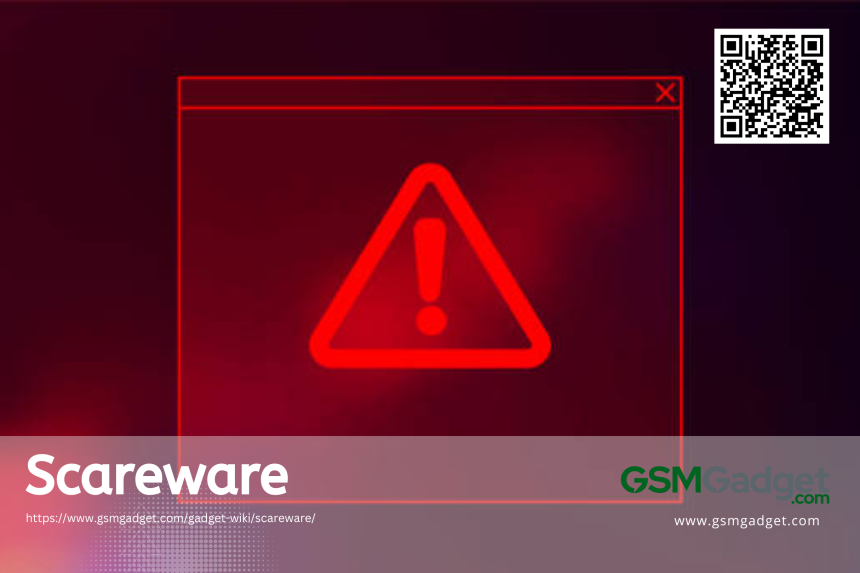Scareware is a form of malicious software that uses social engineering to exploit human emotions, primarily fear, to trick users into making impulsive decisions. It often disguises itself as legitimate security software and bombards users with alarming pop-up messages and fake system alerts, falsely claiming that their computer is infected with numerous viruses or under serious threat. These urgent, deceptive warnings are designed to panic users into downloading and purchasing fraudulent antivirus solutions or handing over sensitive personal information. Such actions can result in additional malware infections, financial loss, or identity theft. Recognizing and understanding scareware is essential for maintaining cybersecurity and protecting sensitive data against these manipulative cyber threats in our digital age.
Specification Table of Scareware
| Specification | Details |
| Name | Scareware |
| Type | Malicious software (malware) |
| Category | Social engineering / Fraudware |
| Primary Objective | To scare users into believing their computer is infected with a virus or other malware |
| Common Tactics |
|
| Distribution Methods |
|
| Payload |
|
| Monetization |
|
| Indicators of Compromise |
|
| Prevention |
|
| Removal |
|
| Legal Consequences | Distributing scareware is illegal and can lead to criminal charges |
| Example | FakeAV, Cyber Security, Antivirus 2010 |
History of Scareware
The history of scareware dates back to the early 1990s, with one of the first instances being the NightMare program in 1990, which shocked users of Amiga computers with a graphic display designed to incite fear. Since then, scareware has evolved from simple pop-up ads and bogus security alerts in the late 1990s and early 2000s to more sophisticated forms that masquerade as legitimate security software, using social engineering to exploit users’ fears of viruses and security breaches. Despite advancements in cybersecurity and increased user awareness, scareware continues to be a significant threat, often through fake antivirus pop-ups that trick users into purchasing harmful software, leading to financial and data loss. As internet usage has grown, so has the complexity of scareware, which now includes a variety of rogue security software and ransomware, constantly adapting to exploit the digital environment’s vulnerabilities.
How does Scareware Works?
Scareware preys on users’ fear and urgency, masquerading as legitimate security software to trick them into installing malicious programs or paying for unnecessary services. It often bombards the victim with alarming pop-up messages claiming that their system is infected with numerous viruses. Here’s a breakdown of how this deceptive tactic operates:
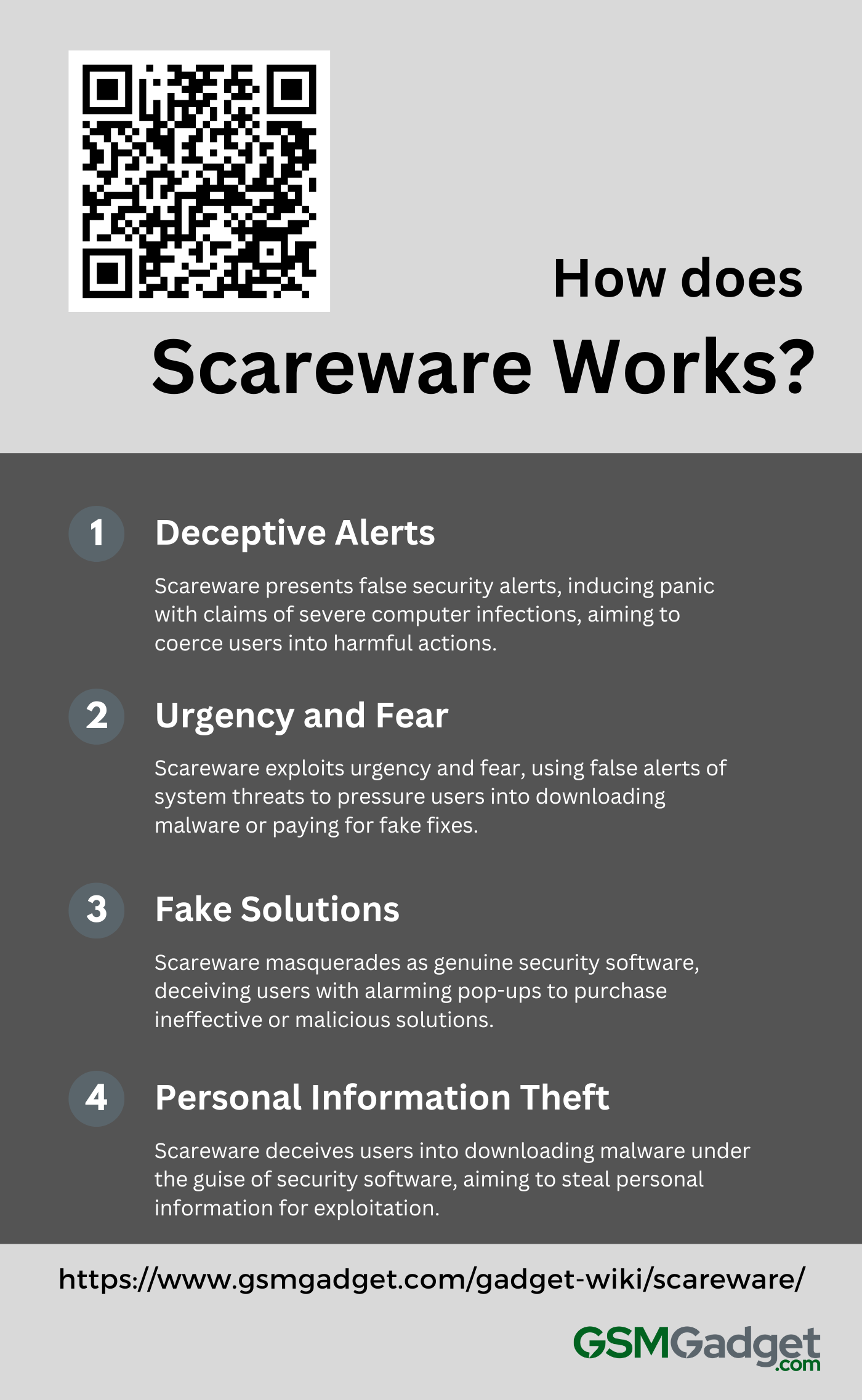
1. Deceptive Alerts
Scareware preys on users by presenting deceptive alerts that falsely warn of severe computer infections or security breaches, leveraging fear to manipulate users into making rash decisions. These alerts are cunningly crafted to resemble authentic system warnings, complete with official logos and complex terminology, to create a false sense of urgency. The ultimate aim is to coerce users into downloading harmful software or visiting scam websites, and sometimes to extort money for bogus security solutions. This form of social engineering capitalizes on the user’s concern for their digital well-being, transforming baseless threats into lucrative frauds. Consequently, victims of scareware may end up with additional malware that compromises their data and financial security.
2. Urgency and Fear
Scareware leverages urgency and fear to manipulate users into quick, often detrimental actions by presenting false alerts of severe system threats, such as viruses or illegal activities. These alerts, which mimic legitimate security notifications, are designed to appear credible and create a sense of immediate danger through alarming language and countdown timers. The deceptive strategy pressures users to hastily download counterfeit antivirus software, pay for unnecessary fixes, or unintentionally install malware. This exploitation of natural protective instincts can lead to compromised security and privacy, as well as potential financial losses and additional malware infections. The effectiveness of scareware lies in its ability to convincingly push users into acting against their own best interests under the guise of urgency.
3. Fake Solutions
Scareware employs a deceptive strategy, presenting itself as genuine security software to dupe users into thinking their systems are infected with viruses or malware. It exploits fear by displaying alarming pop-ups or system alerts that mimic credible warnings from trusted sources, convincing users that immediate action is necessary. Victims are prompted to buy a ‘full version’ of this fraudulent software to eliminate the non-existent threats. Unfortunately, these solutions are typically ineffective or malicious, potentially introducing malware that can lead to more severe issues, such as data theft or system compromise.
4. Personal Information Theft
Scareware preys on users’ fears by presenting itself as genuine security software or critical system alerts, using deceptive messages to create a false sense of urgency about non-existent threats. Victims are duped into downloading what they believe is a solution, but is actually malware aimed at stealing personal information. Once installed, the malware stealthily gathers sensitive data, including passwords and financial details, which cybercriminals can exploit for identity theft, financial fraud, or for sale on the dark web. These scareware campaigns are designed to look credible and urgent, manipulating users through social engineering to take immediate, but harmful, action.
Difference between scareware and ransomware
Scareware and ransomware are both forms of malicious software that prey on users, yet they employ distinct tactics of intimidation and control. Scareware deceives users into believing their system is at risk, using fake alerts and exaggerated threats to coerce them into buying unnecessary software or downloading further malware disguised as a security fix. Ransomware, conversely, poses a severe threat by encrypting a user’s data and barring access to their files or systems until a ransom—often demanded in cryptocurrency—is paid for the decryption key. While scareware uses psychological scare tactics to manipulate and provoke user action, ransomware wields the power to directly disrupt access, demanding compliance and making it an especially formidable cyber threat.
Examples of common scareware
Scareware is a deceptive software that uses fear tactics to trick users into downloading harmful programs under the guise of resolving non-existent security threats. These attacks often manifest through alarming pop-ups or fake system alerts, convincing users that immediate action is necessary. Here are some typical examples of scareware that users might encounter.
- SpySheriff
- WinAntivirus
- Personal Antivirus
- TheSpyBot
- ErrorSafe
- WinFixer
- DriveCleaner
- Spylocked
- Antivirus360
- PC Protector
Typical signs of scareware
Scareware preys on users’ fears with alarming messages and urgent warnings that often mimic legitimate cybersecurity alerts. These deceptive tactics are designed to trick individuals into believing their systems are compromised and to take immediate action. Below are the typical signs of scareware that users should be aware of to protect themselves from these malicious attacks.
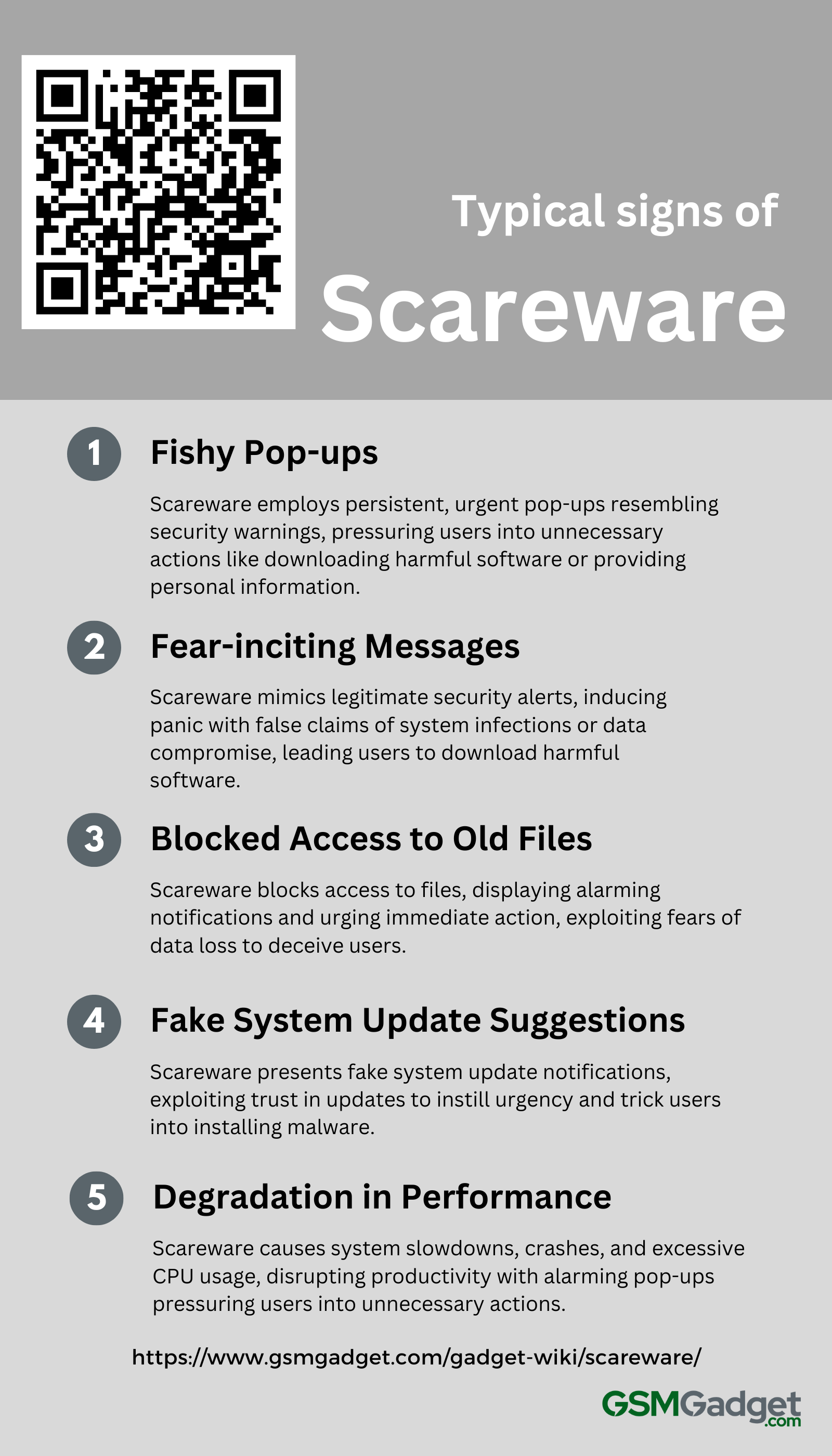
1. Fishy Pop-ups
Scareware typically reveals itself through persistent and alarming pop-ups that imitate authentic security warnings, using urgent language to falsely alert users of non-existent threats like viruses or malware. These pop-ups aggressively push for hasty actions, such as downloading unnecessary software, providing personal information, or making payments to address these invented dangers. Telltale signs of these fraudulent alerts include their difficulty to close, use of bold and dramatic visuals, and often poor grammar or spelling errors. Users should remain wary of these unsolicited and exaggerated messages and instead depend on reputable, verified security tools for real protection against threats. Recognizing these characteristics is essential to safeguard against scareware’s attempts to manipulate fear for nefarious purposes.
2. Fear-inciting Messages
Scareware leverages fear-inciting messages to exploit users’ anxieties, often imitating legitimate security alerts to suggest that their system is infected or personal data is compromised, demanding urgent action. These deceptive notifications employ urgent language and alarming visuals, such as fake virus scans and security alerts with pressing calls to action, to create a false sense of danger and urgency. They are designed to look like real antivirus software warnings, sometimes using countdown timers and a flood of pop-ups to intensify the panic. Users are misled into downloading and purchasing unnecessary and harmful software, believing it to be a necessary step for protection. Awareness of these scare tactics is essential to prevent financial loss, data breaches, and additional malware infections.
3. Blocked Access to Old files
Blocking access to your old files displaying alarming notifications and causing unusual system behavior. These warning signs exploit the user’s fear of data loss, often presenting dire messages that your files are at risk and urging you to take immediate, but misguided, action such as purchasing a fake security solution or downloading a harmful ‘fix.’ Such responses are generally part of the scam, potentially leading to further malware installation or financial extortion without resolving the issue. It’s essential to treat these warnings with a healthy dose of skepticism and confirm their authenticity using reputable anti-malware tools or consulting IT professionals. Recognizing these symptoms swiftly is key to preventing more significant security compromises on your device.
4. Fake System Update Suggestions
Scareware frequently disguises itself as legitimate system update notifications, exploiting users’ trust in such prompts to create a false sense of urgency and fear. These fake alerts, often encountered during internet browsing, may initially appear convincing with official logos and language but typically betray themselves with typographical errors, overly urgent messages, or links to suspicious websites. Clicking on these can result in the installation of malware or compromise of personal data. To protect against these threats, it is imperative for users to scrutinize update notifications for authenticity, refrain from clicking on pop-up messages, and instead verify updates directly through the official software provider’s website, while also utilizing trusted security software.
5. Degradation in Performance
Scareware is notorious for causing a significant decline in system performance, manifesting as a sudden slowdown in processing speed, frequent crashes, and excessive CPU usage due to hidden, resource-intensive background processes. These activities not only lead to extended boot times and sluggish responses from applications but also compromise the overall efficiency of the computer. Additionally, scareware often bombards users with persistent and alarming pop-up notifications, which disrupt workflows and deceitfully suggest immediate action to resolve fabricated issues, pressuring users into acquiring unneeded and potentially dangerous software. This combination of performance issues and false alerts is a deliberate scare tactic to create urgency and exploit user concerns for profit.
Types of Scareware
In the ever-evolving landscape of cyber threats, scareware stands out as a particularly insidious tactic used by cybercriminals. This form of malware preys on users’ fears, tricking them into downloading harmful software under the guise of resolving non-existent security threats. Below, we delve into the various types of scareware, shedding light on their mechanisms and the dangers they pose.
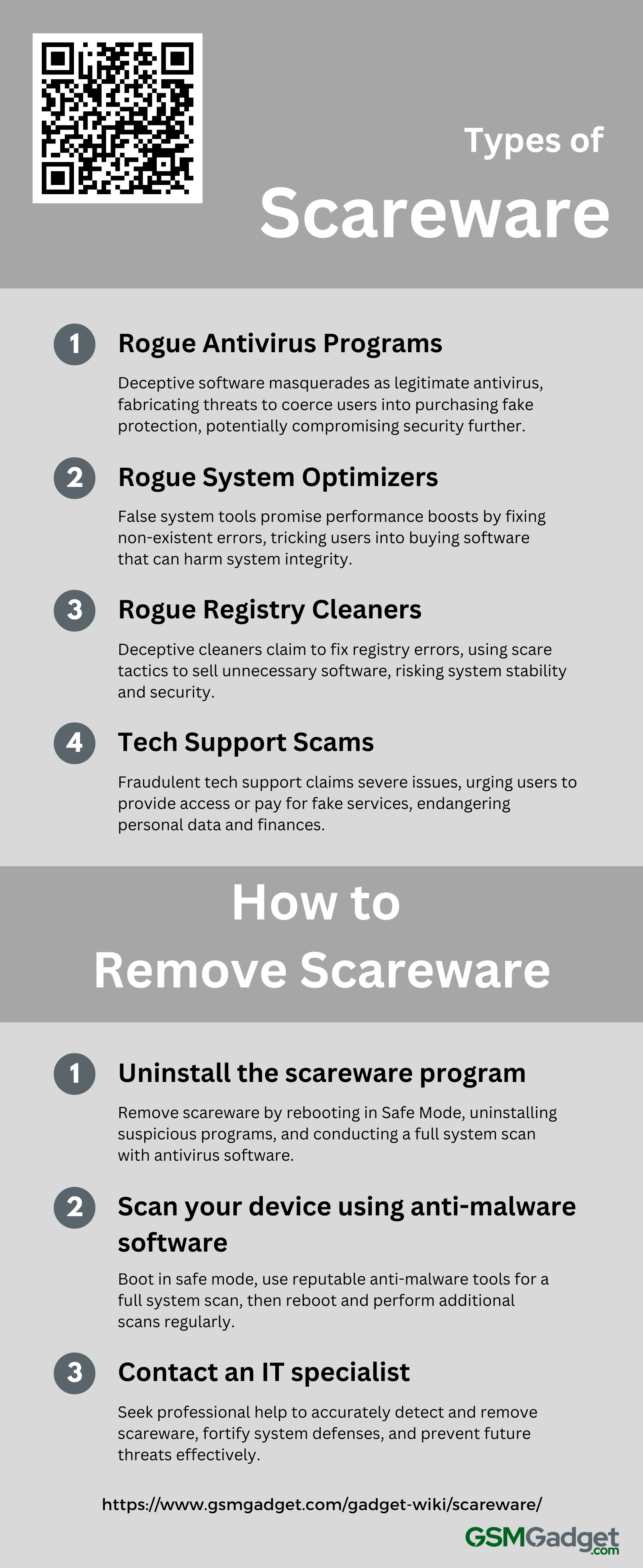
1. Rogue antivirus programs
Rogue antivirus programs, a common form of scareware, pose as genuine security software to trick users into thinking their systems are compromised by fictitious malware. These deceptive applications produce false alarms and system scans that claim to find threats, coercing users into buying a “full version” to eliminate these non-existent infections. Despite their professional appearance and urgent notifications, they offer no real protection and may compromise system security further by installing additional malware or pilfering personal information. Users are advised to trust only reputable antivirus solutions and remain wary of unsolicited security warnings that seem overly pressing or too beneficial to be credible. Names like “AntivirusXP” and “WinAntivirus” exemplify such scams, sounding trustworthy but designed solely to deceive.
2. Rogue system optimizers
Rogue system optimizers are a form of scareware that falsely claim to improve computer performance by fixing system errors and optimizing settings. These malicious programs deceive users with exaggerated diagnostics and alarming alerts about non-existent issues, coercing them into purchasing a full version to address these fabricated problems. However, they often result in reduced system performance and can jeopardize security by installing further harmful software or stealing personal information. It is crucial for users to be vigilant and trust only established, reputable system tools to prevent falling prey to these scams, which offer no genuine benefits and pose serious risks to data and system integrity.
3. Rogue registry cleaners
Rogue registry cleaners, a prevalent type of scareware, falsely present themselves as beneficial tools for system optimization, luring users with exaggerated claims of detecting and fixing critical registry errors. These applications frequently employ scare tactics through alarming pop-up messages and sham system scans to create a false sense of urgency, pushing users to purchase a paid version to resolve fabricated issues. Far from enhancing system performance, these rogue cleaners can delete essential registry keys and potentially install malware, undermining both system stability and security. Users should exercise caution, disregarding unsolicited advertisements for registry cleaners and instead opting for reputable, trusted software for system maintenance to safeguard personal information and ensure system integrity.
4. Tech support scams
Tech support scams are a sinister type of scareware where fraudsters, often posing as representatives from well-known tech companies, claim to have identified severe issues on a user’s computer. They employ convincing tactics such as pop-up messages, emails, or phone calls to create a sense of urgency for the user to act. These scammers typically request remote access to the device or demand payment for unnecessary services and software, putting the user’s financial security and personal data at risk. They leverage the guise of legitimacy by using official logos and technical jargon to deceive victims into believing their computers are infected with malware. It’s crucial for users to remain skeptical of unsolicited tech support communications, to independently verify the authenticity of such claims, and to refrain from giving out personal information or making payments to unverified sources.
How to Remove Scareware
Scareware can be a daunting challenge, tricking users into downloading harmful software by exploiting their fears. Removing this type of malware requires careful steps to ensure that your device is thoroughly cleansed and secure. Below, we outline a systematic approach to effectively eliminate scareware from your system.
1. Uninstall the scareware program
To effectively remove scareware, start by rebooting your computer in Safe Mode to prevent the scareware from executing on startup. For Windows, access the Control Panel, navigate to ‘Programs and Features,’ and uninstall any suspicious applications; Mac users can find and drag the scareware from the Applications folder to the Trash. It’s essential to select the scareware, which may be disguised with a legitimate name, and follow the on-screen prompts to uninstall it. After removal, perform a full system scan with trusted antivirus software to ensure all traces of the scareware are eliminated and to safeguard your system against other potential threats. This comprehensive approach will help maintain your computer’s security and performance.
2. Scan your device using anti-malware software
To effectively combat scareware, start by booting your device in safe mode to prevent the malicious software from running. Employ a reputable anti-malware program with up-to-date definitions, such as Norton 360, Malwarebytes, or Avast, and perform a full system scan to detect and isolate any scareware. These tools will meticulously search through system files, applications, and hidden directories to identify and remove scareware, often providing options to quarantine or delete the threats. After the removal process, reboot your device normally and conduct additional scans to ensure complete eradication of the scareware. To maintain your device’s security, regularly update your anti-malware software and perform routine scans to guard against new variants of scareware and other cyber threats.
3. Contact an IT specialist
To effectively combat scareware, enlisting the help of an IT specialist is the most secure approach. These professionals are equipped with the expertise and specialized tools needed to accurately pinpoint and remove scareware, safeguarding your system’s integrity and preventing potential spread. They are also adept at advising on security measures and best practices to shield your system from future threats. After purging the scareware, an IT specialist can bolster your computer’s defenses with the latest antivirus updates and enhanced security protocols, providing you with a secure and reliable digital environment. Opting for professional assistance is crucial, as attempting scareware removal on your own may lead to adverse outcomes, underscoring the importance of IT specialists in maintaining digital safety.
Preventing Scareware Attacks
In the digital age, protecting oneself from cyber threats is paramount, and scareware attacks are among the most manipulative tactics used by cybercriminals. These attacks prey on fear, tricking users into downloading malicious software under the guise of urgent security warnings. Understanding and implementing effective prevention strategies is crucial to safeguard your digital well-being.
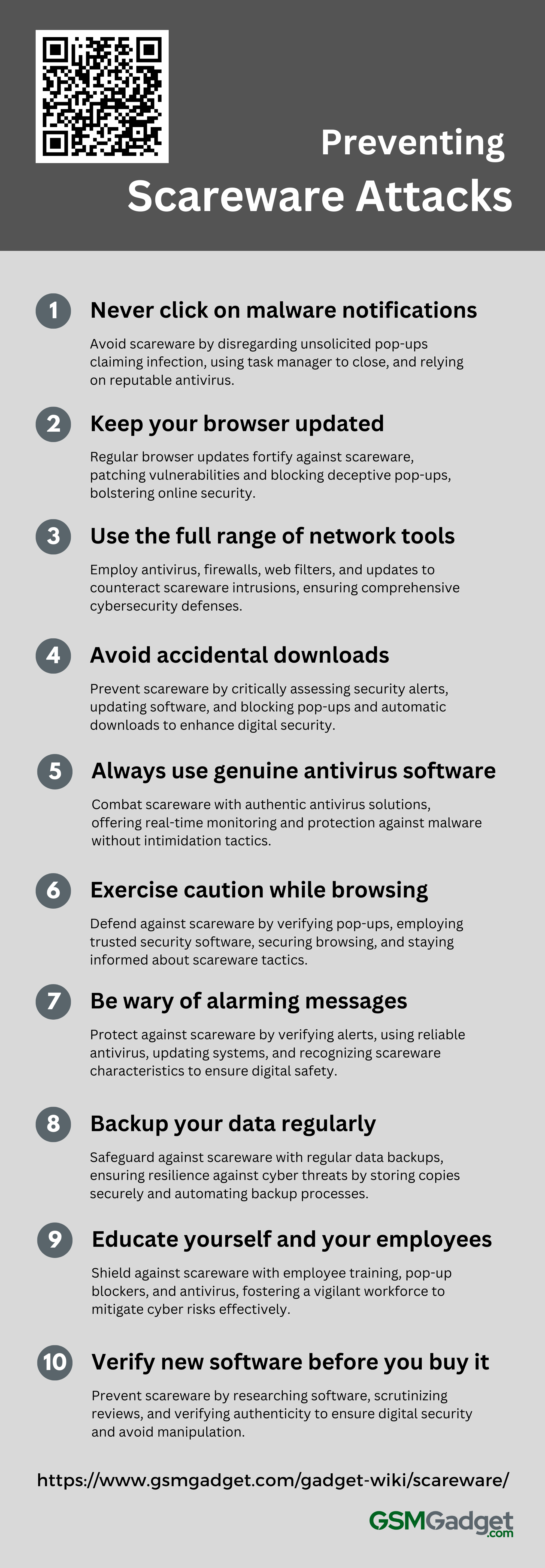
1. Never click on malware notifications
Scareware is a malicious tactic that exploits users’ fears by presenting fake security warnings, designed to look like legitimate antivirus alerts, to provoke a sense of urgency and trick users into taking immediate action. To protect against these fraudulent notifications, it is essential not to click on any unsolicited pop-ups claiming your device is infected and to manage such situations by safely closing the message using task manager or by exiting the browser. Maintaining digital hygiene through regular system scans with trusted security software and keeping all programs updated with the latest patches are effective strategies to counteract scareware. Additionally, understanding that real security applications do not ask for personal details or payments via pop-up alerts can help users remain vigilant and minimize the risk of succumbing to these manipulative scare tactics.
2. Keep your browser updated
Scareware attacks exploit outdated browsers to manipulate users into downloading harmful software, making it crucial to regularly update your browser to protect against these threats. Browser updates patch security vulnerabilities and enhance safety features, helping to block the entry points that cybercriminals use to deploy scare tactics. By enabling automatic updates or frequently checking for them manually, you ensure access to the latest security protocols and maintain a strong defense against deceptive pop-ups and fake alerts. An updated browser not only improves performance and compatibility with websites but also fortifies your online security, safeguarding your personal information from unauthorized access.
3. Use the full range of network tools
To fortify digital environments against scareware attacks, it is essential to employ a comprehensive array of network security tools. Antivirus software with real-time scanning, firewalls, and intrusion detection systems work in concert to detect, block, and monitor for malicious activities and suspicious patterns. Web filtering services and ad blockers further shield users by restricting access to scareware distribution sites and blocking deceptive pop-ups. Regular updates and patches to software are also critical in sealing off potential vulnerabilities. Integrating these defenses into a unified cybersecurity strategy enhances the overall security posture and diminishes the risk of scareware intrusions, thereby protecting both personal and professional data.
4. Avoid accidental downloads
Scareware is a malicious tactic that preys on users’ security fears to trick them into downloading harmful software. To combat this, adopt a vigilant approach online, critically evaluating security alerts and verifying software authenticity through trusted reviews and research. Keep your operating system and browsers updated with the latest security enhancements, and employ robust antivirus tools for added protection. Adjust your browser settings to block unsolicited pop-ups and disable automatic downloads, which are common scareware delivery methods. These strategic defenses can greatly reduce the risk of scareware infiltration and safeguard your digital space.
5. Always use genuine antivirus software
In the digital realm, scareware attacks are a prevalent hazard, exploiting fake antivirus alerts to deceive users into installing harmful software or purchasing superfluous services. To counter these threats, it is essential to utilize authentic antivirus software sourced from trustworthy providers, which are equipped with advanced algorithms and continuously updated threat databases for effective detection and neutralization. Genuine antivirus programs offer real-time monitoring to swiftly identify and address any dubious activities, thereby reinforcing system defenses and protecting sensitive information from being compromised. Unlike scareware, reputable antivirus solutions provide precise threat assessments without resorting to intimidation or false alarms, and maintaining these systems with the latest updates and regular scans is a critical strategy in diminishing the risk of malware infiltrations.
6. Exercise caution while browsing
To safeguard against scareware attacks, it’s crucial to scrutinize pop-up warnings and software updates for authenticity, as these can disguise themselves as legitimate alerts. Ensure the use of trusted antivirus and anti-malware software with real-time protection, and keep your systems updated to close off security loopholes. Secure your browsing by using encrypted connections—signified by “https://”—and validate the credibility of websites by their domain names and design. Employ ad-blockers and pop-up blockers to fend off intrusive ads, and stay informed about the typical scareware tactics, which often involve exaggerated warnings and pressing demands for immediate action. By integrating these security measures and staying vigilant, you can significantly diminish the risk of scareware intrusions, thereby protecting both personal and organizational digital assets.
7. Be wary of alarming messages
Scareware attacks exploit users’ fears with fraudulent warnings, often disguised as legitimate system notifications, to coerce immediate and unwarranted action. To counter these threats, it’s crucial to approach unsolicited alerts with skepticism and verify their authenticity through official sources. Protecting your devices with current, trustworthy antivirus software and regularly updating your operating system and applications are key steps in building a robust defense. Enabling pop-up blockers and educating yourself about the characteristics of scareware, such as hyperbolic language and pressing demands, can further help in avoiding these deceptive tactics and maintaining your digital safety.
8. Backup your data regularly
In the realm of cybersecurity, safeguarding against scareware attacks is crucial, and one of the most effective defenses is the regular backup of essential data. By consistently updating copies of your files and storing them in secure, off-site or cloud storage solutions, you ensure that your data is protected and can be quickly restored, thus reducing downtime and operational disruptions. This strategy is not only vital for defending against scareware but also other malware threats like ransomware, which may encrypt or destroy your data. Automating backup processes can further strengthen your security posture by ensuring regularity and minimizing human error. It’s imperative to regularly check that your backups are complete and readily accessible, serving as a reliable safety net against a spectrum of cyber threats.
9. Educate yourself and your employees
In the realm of cybersecurity, scareware is a devious tactic that exploits fear to trick users into installing harmful software, posing a significant threat to data security and financial stability. To shield your organization from these attacks, it’s essential to foster a culture of vigilance and continuous education on cybersecurity. Employees must be adept at identifying scareware’s red flags, like deceptive pop-ups and fake security alerts, and should approach unsolicited communications with a critical eye, always verifying software authenticity. Conducting regular training sessions and equipping your systems with up-to-date antivirus solutions and pop-up blockers are proactive steps that can greatly reduce the risk of scareware penetration. By maintaining an informed and cautious workforce, you enhance your digital defenses, ensuring your organization’s resilience against these manipulative threats.
10. Verify new software before you buy it
To protect against scareware attacks, it’s essential to thoroughly vet any new software before purchase. Scareware deceives users into buying software under the false pretense of security threats, so diligence is key: research the software provider, scrutinize reviews from credible sources, and verify the absence of scareware affiliations. Keep your security software current to detect potential scareware. Watch for warning signs like unclear feature descriptions, aggressive marketing, or unwarranted access requests. Consulting trusted security websites for software validation further fortifies your defenses, ensuring your digital space remains secure.
